
Mostar is a city and the administrative center of Herzegovina-Neretva Canton of the Federation of Bosnia and Herzegovina, an entity of Bosnia and Herzegovina.

Široki Brijeg, formerly known as Lištica, is a city and the administrative center of West Herzegovina Canton of the Federation of Bosnia and Herzegovina, an entity of Bosnia and Herzegovina. As of 2013, the town itself had a population of 6,149 and the municipality of 28,929.
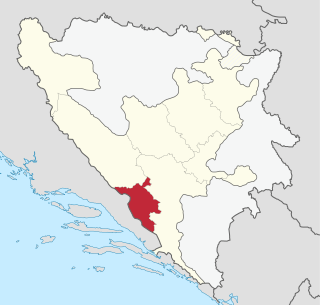
The West Herzegovina Canton is one of the cantons of the Federation of Bosnia and Herzegovina. The West Herzegovina Canton is in the Herzegovina region in the southwest of Bosnia and Herzegovina. Its seat of government is in Široki Brijeg, while other municipalities within the Canton are Grude, Ljubuški and Posušje. It has 94,898 inhabitants, of whom more than 98% are ethnic Croats.

The Neretva, also known as Narenta, is one of the largest rivers of the eastern part of the Adriatic basin. Four HE power-plants with large dams provide flood protection, power and water storage. It is recognized for its natural environment and diversity of its landscape.

Livno is a city and the administrative center of Canton 10 of the Federation of Bosnia and Herzegovina, an entity of Bosnia and Herzegovina. It is situated on the river Bistrica in the southeastern edge of the Livno Field at the foot of Kruzi plateau which are located beneath the Cincar mountain and rocky hill Crvenice. Livno is the centre of the Canton 10 which mainly covers an area of the historical and geographical region of Tropolje. As of 2013, it has a population of 37,487 inhabitants.
Bosniaks are a South Slavic ethnic group, native to Bosnia and Herzegovina and the region of Sandžak. The term Bosniaks was re-instated in 1993 after decades of suppression in the Socialist Federal Republic of Yugoslavia. The Bosniak Assembly adopted the ethnonym to replace "Bosnian Muslims." Scholars believe that the move was partly motivated by a desire to distinguish the Bosniaks from the fabricated and imposed term Muslim to describe their nationality in the former Yugoslavia. These scholars contend that the Bosniaks are distinguishable from comparable groups due to a collective identity based on a shared environment, cultural practices and experiences.
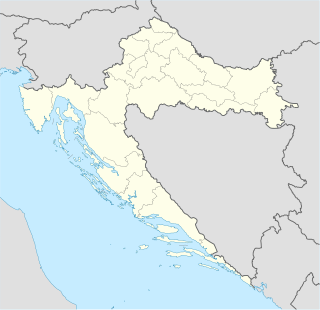
Operation Swath-10 was a military offensive undertaken by the Croatian Army against the SAO Western Slavonia Territorial Defense Forces on Bilogora Mountain in western Slavonia. Occurring from 31 October to 4 November 1991, during the Croatian War of Independence, the operation was a Croatian victory and its success set the stage for follow-up advances by Croatian forces on Papuk Mountain in Operation Papuk-91 in late November and December. By the end of the year the HV gained control of Papuk, securing transport routes between eastern Slavonia and the rest of Croatia.

The Croats of Bosnia and Herzegovina, often referred to as Bosnian Croats or Herzegovinian Croats, are the third most populous ethnic group in the country after Bosniaks and Serbs, and are one of the constitutive nations of Bosnia and Herzegovina. Croats of Bosnia and Herzegovina have made significant contributions to the culture of Bosnia and Herzegovina. Most Croats declare themselves Roman Catholics and speakers of Croatian.

Operation Neretva '93 was an Army of the Republic of Bosnia and Herzegovina (ARBiH) operation against the Croatian Defence Council (HVO) in September 1993 on a 200 km long front from Gornji Vakuf to south of Mostar, one of its largest of the year, during the Croat–Bosniak War. The ARBiH made limited gains in the area of northern Herzegovina and around Mostar, but did not achieve a breakthrough to the southern Neretva, where the HVO retained control. The operation was halted in October. During the operation, dozens of Croat civilians were killed in the Grabovica and Uzdol massacres.

The Croat–Bosniak War was a conflict between the Republic of Bosnia and Herzegovina and the self-proclaimed Croatian Republic of Herzeg-Bosnia, supported by Croatia, that lasted from 18 October 1992 to 23 February 1994. It is often referred to as a "war within a war" because it was part of the larger Bosnian War. In the beginning, Bosniaks and Croats fought in an alliance against the Yugoslav People's Army (JNA) and the Army of Republika Srpska (VRS). By the end of 1992, however, tensions between Bosniaks and Croats increased. The first armed incidents between them occurred in October 1992 in central Bosnia. Their military alliance held out until early 1993 when their cooperation fell apart and the two former allies engaged in open conflict.
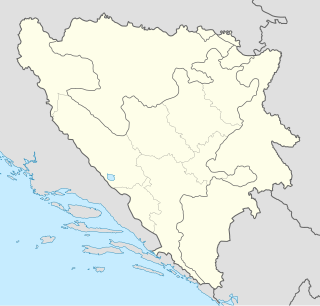
Goranci is the village in Bosnia and Herzegovina, near Mostar, part of Mostar municipality.

Herzegovina is the southern and smaller of two main geographical regions of Bosnia and Herzegovina, the other being Bosnia. It has never had strictly defined geographical or cultural-historical borders, nor has it ever been defined as an administrative whole in the geopolitical and economic subdivision of Bosnia and Herzegovina.

The Mostar Operation was a series of Yugoslav Partisan military operations in Herzegovina from February 6–15, 1945.

The siege of Mostar was fought during the Bosnian War first in 1992 and then again later in 1993 to 1994. Initially lasting between April 1992 and June 1992, it involved the Croatian Defence Council (HVO) and the Army of the Republic of Bosnia and Herzegovina (ARBiH) fighting against the Serb-dominated Yugoslav People's Army (JNA) after Bosnia and Herzegovina declared its independence from Yugoslavia. That phase ended in June 1992 after the success of Operation Jackal, launched by the Croatian Army (HV) and HVO. As a result of the first siege around 90,000 residents of Mostar fled and numerous religious buildings, cultural institutions, and bridges were damaged or destroyed.

Operation Jackal, also known as Operation June Dawns, was an offensive of the Bosnian War fought between a combined Croatian Army (HV) and Croatian Defence Council (HVO) army against the Army of Republika Srpska (VRS) from 7–26 June 1992. The offensive was a Croatian pre-emptive strike against the VRS, a Bosnian Serb military formed in May 1992 from Yugoslav People's Army (JNA) units that were stationed in Bosnia and Herzegovina. The HV concluded that the JNA offensive operations of April and May 1992, resulting in the capture of Kupres and much of the Neretva River valley south of Mostar, were aimed at capturing or threatening the Croatian Port of Ploče and possibly Split. To counter this threat, the Croatian leadership deployed the HV, under the command of General Janko Bobetko, to the "Southern Front" including the area in which Operation Jackal was to be conducted.
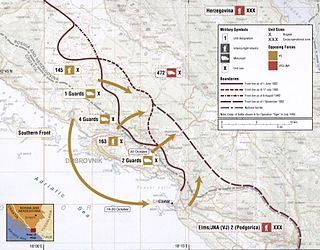
Operation Tiger was a Croatian Army (HV) offensive conducted in areas of Croatia and Bosnia and Herzegovina near Dubrovnik between 1 and 13 July 1992. It was designed to push the Army of Republika Srpska (VRS) away from the city towards Popovo field and secure a supply route via Rijeka Dubrovačka, which was gained in early June as the siege of Dubrovnik by the Yugoslav People's Army (JNA) was lifted. The operation's success was facilitated by the establishment of the HV's Southern Front command and the successful conclusion of the May–June 1992 operations against the VRS in the Neretva River valley, which concluded with Operation Jackal.

The Battle of Kupres was a battle of the Bosnian War, fought between the Bosnian Croat Territorial Defence Force supported by the Croatian Army troops on one side and the Yugoslav People's Army, augmented by the Bosnian Serb TO on the other at the Kupres Plateau, on 3–11 April 1992. During the fighting on 8 April, the Bosnian Croat TO was reorganised as the Croatian Defence Council. The objective of the battle was to control the strategic Kupres Plateau, a major supply route.
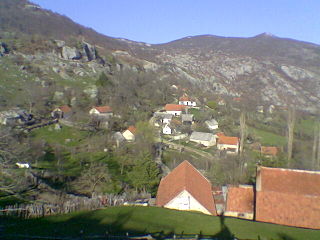
In June 1941, Serbs in eastern Herzegovina rebelled against the authorities of the Independent State of Croatia, an Axis puppet state established during World War II on the territory of the defeated and occupied Kingdom of Yugoslavia. As the NDH imposed its authority, members of the fascist Ustaše ruling party began a genocidal campaign against Serbs throughout the country. In eastern Herzegovina, the Ustaše perpetrated a series of massacres and attacks against the majority Serb population commencing in the first week of June. Between 3 and 22 June 1941, spontaneous clashes occurred between NDH authorities and groups of Serbs in the region.

Poles are one of 17 constitutionally recognized ethnic minorities in Bosnia and Herzegovina. They arrived during the Austro-Hungarian rule in Bosnia and Herzegovina and settled mostly in the north of Bosnia proper, bringing new technology and skilled manpower. Their destiny was tied closely to that of the Ukrainian minority, with whom they joined the Yugoslav Resistance after the Axis invasion of Yugoslavia. After the Second World War, Bosnian Poles faced difficulties with establishing their rights as a minority as well as persecution by local population and remaining fascist collaborators. This forced a vast majority to answer the Polish government's call for repatriation. There were around 30,000 Poles in Bosnia and Herzegovina in 1930, while their number today is estimated to be less than a thousand, with communities in the major cities of Sarajevo, Banja Luka, Zenica and Mostar.
Operation Bura was a joint offensive conducted by the Croatian Defence Council and the Army of the Republic of Bosnia and Herzegovina with help from the Croatian Army and numerous Mujahideen formations on the territories held by the Nevesinje and Bileća brigades of the Army of Republika Srpska during the Bosnian War.
















